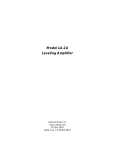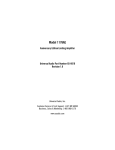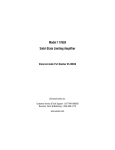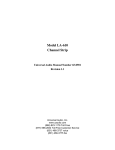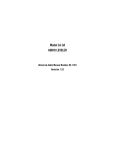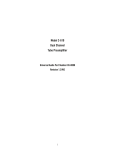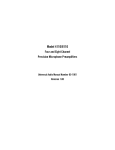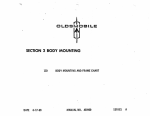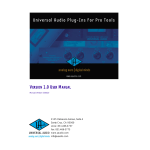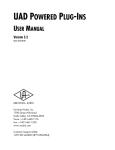Download Universal Audio 1176LN User`s guide
Transcript
Model 1176LN Solid-State Limiting Amplifier Universal Audio, Inc. www.uaudio.com PO Box 3818 Santa Cruz CA 95063-3818 Universal Audio 1176LN Thank you for purchasing this reproduction of the classic 1176LN compressor. When my father designed this product, he was very proud of his accomplishment. Being a recording engineer himself, this was a piece of gear he used extensively. He was also very proud of its reception by his peers in both the recording and broadcast industries. In making our version of this classic piece of equipment, we have taken great care to make a product that my father would have been proud of. Throughout the development of this product our philosophy has remained clear: Stay true to the original. There are good reasons why certain pieces of gear have become classics, and we wanted to make sure that we captured this accurately. You may be familiar with the fact that there were many versions of the 1176 produced throughout the years. We patterned our reproduction on the D/E versions. These versions were characterized by the transformer input stage, LN circuitry, and the class A (1108 style) output stage. Later versions replaced the class-A output stage with a push-pull classAB output stage, and eventually replaced the transformer input with a differential op-amp circuit. That highly recognizable blackface 1176 sound was best captured by the version that we are reproducing. As for the future of Universal Audio, we are making more reproductions of classic recording equipment beyond the 1176LN and the Teletronix LA2A. We are interested in your opinions about your favorite vintage pieces, what you like or didn't like, what you'd love to own but can't find any longer, etc. Additionally, Universal Audio will produce new quality audio products designed to meet the needs of the modern recording studio yet retain the character of classic vintage equipment. Developing these products has truly been a special experience, enjoyed by all who have been involved. While it is on the surface a business endeavor, it's really been so much more than that - equal parts a sentimental and technical adventure. More than anything, we have been surprised and touched by the overwhelming response and warm support that we have received since we announced the return of Universal Audio. We thank you, and we thank my father, Bill Putnam. Sincerely, Bill Putnam ii User’s Guide 1176LN Universal Audio, Inc. PO Box 3818 Santa Cruz, CA 95063-3818 (831) 454-0630 voice (831) 454-0689 fax www.uaudio.com Universal Audio Part Number 1176-M01. Revision 1.02 Notice This manual provides general information, preparation for use, installation and operating instructions for the Universal Audio 1176LN, Limiting Amplifier. The information contained in this manual is subject to change without notice. Universal Audio, Inc. makes no warranties of any kind with regard to this manual, including, but not limited to, the implied warranties of merchantability and fitness for a particular purpose. Universal Audio, Inc. shall not be liable for errors contained herein or direct, indirect, special, incidental, or consequential damages in connection with the furnishing, performance, or use of this material. Copyright 2000 Universal Audio, Inc. All rights reserved. This manual and any associated software, artwork, product designs, and design concepts are subject to copyright protection. No part of this document may be reproduced, in any form, without prior written permission of Universal Audio, Inc. Trademarks 1176, LA-2A, and the Universal Audio, Inc. logo are trademarks of Universal Audio, Inc. Other company and product names mentioned herein are trademarks of their respective companies. iii UNIVERSAL AUDIO 1176LN ................................................................................. II 1176LN SPECIFICATIONS ..............................................................................................................................1 INSTALLATION ...............................................................................................................................................2 Rear Panel Connections ............................................................................................................................... 2 230 Volt Operation ..................................................................................................................................... 2 Stereo Interconnection ................................................................................................................................. 2 1176 LN OPERATION ...................................................................................................................................3 Meter Function / On-Off Pushbutton Switches ............................................................................................ 3 Compression Ratio ....................................................................................................................................... 3 Input Level..................................................................................................................................................... 3 Output Level ................................................................................................................................................. 3 Attack Control............................................................................................................................................... 3 Release Control ............................................................................................................................................ 4 Stereo Operation ......................................................................................................................................... 4 CALIBRATION ................................................................................................................................................5 “Q” Bias........................................................................................................................................................ 5 Meter Driver Null ......................................................................................................................................... 5 Zero Set ........................................................................................................................................................ 5 Stereo Interconnection ................................................................................................................................. 5 THEORY OF OPERATION .................................................................................................................................7 Overview ...................................................................................................................................................... 7 1176 LN Input Section................................................................................................................................. 8 Gain Reduction Stage .................................................................................................................................. 8 LN Circuitry................................................................................................................................................... 9 Output Amplifier........................................................................................................................................... 9 Gain Reduction Control Circuit..................................................................................................................10 HISTORY .....................................................................................................................................................12 iv 1176LN Specifications ! Input Impedance: 600 Ω, bridged-T control (floating) ! Output Load Impedance: 600 Ω (floating) ! External Connections: XLR Connectors / Original Jones barrier strip ! Frequency Response: +/- 1 dB. 20Hz to 20 kHz ! Gain: 45 dB, +/- 1dB ! Distortion: Less than 0.5% T.H.D. from 50 Hz to 15 kHz with limiting, at 1.1 seconds release setting. Output of +22 dBm with no greater than 0.5% T.H.D. ! Signal-Noise Ratio: Greater than 81 dB with input signal at threshold of limiting, over a bandwidth of 30 Hz to 18 kHz ! Attack Time: Adjustable from 20 to 800 microseconds. ! Release Time: Adjustable from 50 milliseconds to 1.1 seconds. ! Stereo Interconnection: Using 1176 SA stereo interconnect accessory ! Power Requirements: 110V / 220V operation ! Dimensions: 3.5” vertical, for mounting in standard 19” rack. ! Weight: 11 lbs. (Shipping weight 14.5 lbs.) 1 Installation Rear Panel Connections Both XLR style connectors as well as the original terminal strip are provided for both input and output connections. Additionally, as in the original unit, terminals are provided for the connection of a remote meter. When using a remote meter, remove the strap on the barrier strip and connect the leads to a standard VU meter. 230 Volt Operation The 1176LN can be configured for either 115 or 230 Volt operation. This is selected by the voltage selection switch on the rear panel. Stereo Interconnection Two 1176 LN units can be linked for stereo mode operation using the 1176 SA stereo adapter. See the ‘Calibration’ chapter for instructions on calibrating the 1176 SA. 2 1176 LN Operation Meter Function / On-Off Pushbutton Switches The pushbutton switches located to the right of the meter are used to determine the metering mode as well as to turn the unit on and off. The 1176LN is turned on by selecting any pushbutton other than the Off selection. The VU meter can be used to indicate either Gain Reduction or output level. When used to measure output level, the user can choose either +4 or +8 dBm output. The Meter function is determined using the four pushbuttons to the right of the meter. When GR is depressed, the meter reads Gain Reduction level in dB. When the +4 or +8 buttons are depressed, the meter displays the limiter output level. When +4 is depressed, a meter reading of 0 corresponds to an output level of +4 dBm. Compression Ratio The four pushbutton switches to the left of the meter control the compression ratio. Four ratios are provided: 20:1, 12:1, 8:1, and 4:1. The 20:1 and 12:1 settings are typically used when peak-limiting is desired, while the 4:1 and 8:1 settings are used for general dynamic range compression. Input Level The 1176LN uses a fixed threshold level, and utilizes the Input Level control to determine the relative threshold as well as the total amount of gain reduction. In order to set the limiter to provide a specific amount of compression, first adjust the Input and Output controls to a fully counterclockwise (CCW) position. Adjust the Attack control a few degree clockwise (CW) so that Gain Reduction is enabled. Use the Meter pushbutton switches so that the meter reads Gain Reduction. Rotate the Input Level control CW until the desired amount of gain reduction is achieved. Output Level Once the desired amount of limiting is adjusted by setting the Input Control, the Output Control can be used to set the required output level. Set the meter to measure the output level by pressing either +4 or +8. Adjust the Output Control until the desired output level is achieved. Attack Control The Attack Control adjusts the time it takes the limiter to respond to an input signal and adjust the gain appropriately. Additionally, when it is in the fully CCW position, 3 compression is disabled. The Attack Control potentiometer allows for an adjustable response time of 20-800 microseconds. The fastest attack time is achieved when the Attack Control is in its fully CW position. Release Control The Release Control allows for an adjustable release time of 50 to 1100 milliseconds. The fastest release time is achieved when the control is in the fully CW position. Stereo Operation When used in stereo operation, the Attack and Release controls on the two units will interact. Controlling the Attack and Release on either of the units controls both units. When connected in a stereo configuration, the fastest attack time is double that of a single unit. 4 Calibration Note: There are no user serviceable parts inside the Universal Audio 1176LN. Unit calibration as well as repair should only be performed only by qualified service personnel. These calibration procedures are provided only for use by qualified service technicians. “Q” Bias The compression threshold is set using R59. Under normal circumstances, this control does not need to be adjusted. The threshold is dependent upon the specific characteristics of the VVR FET (Q1), and it will be necessary to re-adjust it if Q1 is changed. The following procedure is used to set “Q” bias: ! ! ! ! ! Select either +4 or +8 output metering Adjust R59 fully counterclockwise (CCW) Apply a sine wave signal to the limiter Use the Input and Output Controls for 0dB output Slowly adjust R59 CW until the output decreases 1.0 dB Meter Driver Null A multimeter is needed to perform this calibration procedure. ! ! ! ! ! ! ! ! Disconnect any input and output connection on the 1176LN Set multimeter to measure dc volts Depress the Meter GR pushbutton Adjust “0” set potentiometer, R71 (located on the front panel) so that the meter reads near 0 dB Connect the multimeter across R74 Adjust R75 for a minimum voltage reading Disconnect the multimeter Readjust “0” set potentiometer, R71 so that the meter reads 0 dB Zero Set R71, located on the front panel is used to zero the meter. Adjust this potentiometer if the meter needs to be recalibrated. Stereo Interconnection Using the 1176SA, two units may be connected for stereo operation. Use the following 5 procedure to calibrate the 1176 stereo adapter: Remove the signals from both 1176 units Disable the gain reduction on each limiter (rotate both ATTACK controls fully CCW) Connect the 1176-SA to both limiters (This requires two RCA style cables.) Use the METER function pushbutton switches to set both units into GR mode Adjust the potentiometer on the 1176-SA until both meters read 0dB If it is not possible to zero both meters, reverse the stereo interconnect cables and repeat the preceding step ! ! ! ! ! ! 6 Theory of Operation Signal Input Signal Output Input Pre-Amp GR Circuit Output Amp GR Control Circuit Figure 1 - Block Diagram of the 1176LN. Overview Figure 1 shows the block diagram of the 1176LN Limiting Amplifier. Signal limiting and compression is performed by the Gain Reduction section. Before the signal is applied to the Gain Reduction section, the audio signal is attenuated by the Input stage. The amount of attenuation is controlled by the input control potentiometer. The amount of gain reduction as well as the compressor Attack and Release times are controlled by Gain Reduction Control circuit. After Gain Reduction a pre-amp is use to increase the signal level. The Output Control potentiometer is then used to control the amount of drive that is applied to the output amplifier. The 1176LN is a feedback style compressor since the signal level is sensed after the gain reduction is applied to the signal. To GR ck T1 R1A 600 +/- C R2 620 1/4w R3 620 1/4w R1B 600 GND 7 R74 270 Figure 2 – 1176 Input Section 1176 LN Input Section The 1176LN Input Section is comprised of an adjustable passive attenuator followed by a transformer. The purpose of this section is to reduce the signal level so as not to overdrive the FET based gain reduction stage. Additionally, the adjustable input level is used to control the amount of compression. This input circuit was used in Revisions A-F. With Revision G, a differential op-amp input instead of the attenuator / transformer input stage was used. +V R17 6.8k + R13 1M C4 80uF,25V R14 22k from Input Circuit C1 1uF R5 27k R8 1k Q14 C7 1uF, 40V + R9 560k Q2 Q3 NPN 15 Sig In Q1 C28 50uF, 6.4v R23 R85 150 R7 2.2M C6 200pF R12 1k 10k, 2W C5 80uf R88 68k R30 6.8k R6 2.2M C22 .22 To Output Amp C2 27pF R84 180 R10 10k R11 82 R18 180 C9 .22 U1 R86 100 C3 200pF GR sig To Gain Control Circuit R6 1k Figure 3 - 1176LN Gain Reduction stage. Gain Reduction Stage This stage is the heart of the 1176LN limiter, and is where the actual signal compression takes place. Compression is achieved by a Field Effect Transistor (FET) which is used as a variable resistor. In the 1176LN, the FET acts like a resistor whose resistance is controlled by the voltage applied to its gate. The higher the voltage applied to the gate, the smaller the drain-source resistance will be. Figure 4 shows how the FET’s resistance determines the gain of this section. Resistor R5 and the and the FET essentially comprise a voltage divider circuit. The lower the FET’s resistance, the less gain this stage will have. As shown in Figure 4, the FET acts like a variable resistor, whose resistance is determined by the control voltage that is applied to it. Note that the greater the voltage applied to the gate of the FET, the less resistance, hence large signals cause the FET to reduce the gain. As we will see soon, a large input signal 8 will result in a higher voltage from the Gain Control Circuit, which will lower the gain, hence reducing the signal level. This is the basis of the limiting action. Note that the 1176 is a feedback style compressor since the sidechain circuit samples the signal level after the gain reduction. Signal In Signal Out R5 27k Signal In R5 27k Signal Out Q1 GR Control Voltage Figure 4 - Using a FET as a voltage-variable resistor. The combination of R5 and Q1 acts as a voltage divider which controls the gain. LN Circuitry The LN circuit, which appeared in revisions ‘C’ and later, was designed to reduce the distortion that the FET introduced in the gain reduction stage. FETs are inherently nonlinear devices, and any non-linear device will introduce signal distortion. The LN circuitry was designed to ensure that the FET stayed as much within a linear region as possible, thus reducing unwanted distortions. Much of what is now known about the operation and design guidelines of FETs was very new at the time the 1176 was designed. Initially, the decision was made to try to keep the ‘LN circuit’ a secret and file for a patent. In order to accomplish this it was decided to build the ‘LN’ circuit in a separate module. This module was then attached to the circuit board. The first revision to have the LN circuitry was revision C. This was accomplished by attaching an ‘LN module’ to the revision B circuit board. This module turned out to be a problem to manufacture and the decision was made to revise the circuit board to accommodate the LN circuitry without the module. This 1 then became revision D . Output Amplifier The output amplifier is a Darlington pair followed by a class A stage based on a 2N3053 transistor. The 1176 output stage was essentially the same as the Universal Audio 1108 pre-amplifier. The output transformer is a custom transformer designed by Bill Putnam Sr. Aside from offering output impedance matching, the transformer forms an integral part of the feedback network used to stabilize the output stage. Note that later revisions (‘F’ and beyond) used a push-pull (class AB) output stage. 1 Revision E was essentially the same as revision D. Revision E added 220 Volt operation as well as a 10MΩ resistor across the ratio switch to avoid ‘pops’ while changing between compression ratios. 9 To GR Circuit From Pre-Amp output R21 56k, 1/4w 4:1 S1A R20 56k,1/4w 8:1 S2A R19 68k, 1/4w 12:1 S3A 20:1 R75 470,1/4w R6 1k 4:1 S4A U2 + R38 47k Q8 2N3707 50uf C20 50V R47 47k R54 470 Q9 2N3707 R42 180k 2N3707 R48 7.68k R40 2.4k C19 Q10 2N3707 6.8uf, 35V + R49 2.4k CR2 U3 Release Time Control R55 25k R52 47k R43 38.3k R56 5M C21 + R39 4.7k R64 1.5k S4B C27 .022 U3 R37 470k 20:1 Attack Time Control (F.P.) R46 1k Q7 S3B R76 150 S1 C17 1uF R68 1.5k,1/4w 12:1 S2B T&C R22 47k, 1/4w R36 1M R73 560,1/4w 8:1 S1B R50 180 R41 270 R57 270k 80uf,25V R53 47k -10V U3 R46 47k C23 6.8uf,35V + CR3 R35 10k R83 R59 2k "Q" Bias Adj. P.C.B. R60 3.9k Figure 5 – 1176LN Gain Reduction Control Circuit. Gain Reduction Control Circuit This circuit controls the amount of compression as well as the attack and release time of the limiter. The input to this circuit is taken from the output of the preamplifier section, just before the volume control potentiometer (R23). The compression ratio push-button switches determine the level of the signal which is sent to the to the sidechain. This determines the amount of compression. Transistor Q7 acts as a phase inverter which is followed by Q8 , an emitter follower. This signal then feeds CR3 as well as Q9 and Q10 which comprise another phase inverter / emitter follower combination. This is then fed to CR2. Note that the signal applied to CR2 is 180° out or phase with the signal at CR3. Since they are out of phase, the combination of CR2 and CR3 act as a full-wave rectifier. The output of the rectifiers are then filtered by C22 which smooths the signal. This DC voltage is proportional to the level of the input signal. A bias level is applied to the diodes by the Compression Ratio pushbutton switches. This controls the threshold of limiting, and is adjusted for the correct value as determined by the currently selected compression ratio selection. R55 controls the compressors attack time 10 T&C by regulating how fast C22 is charged. Likewise, R56 determines the compressors release time by controlling the rate at which C22 discharges. The output of this stage is then applied to the gate of the FET in the Gain Reduction circuit which in turn controls the gain in the manner previously described. 11 History It was Bill Putnam himself who, in 1966, was responsible for the initial design of the 1176. Its circuit was rooted in the 1108 preamplifier which was also designed by Putnam. As is evident from entries and schematics in his design notebook, he experimented with the recently developed Field Effect Transistor (F.E.T.) in various configurations to control the gain reduction in the circuit. He began using F.E.T.s as voltage variable resistors, in which the resistance between the drain and the source terminals is controlled by a voltage applied to the gate. His greatest challenge was to ensure that distortion was minimized by operating the F.E.T.s within a linear region of operation. After several unsuccessful attempts at using F.E.T.s in gain reduction circuits, Putnam settled upon the straightforward approach of using the F.E.T. as the bottom leg in a voltage divider circuit, which is placed ahead of a preamp stage. The output stage of the 1176 is a carefully crafted class A line level amplifier, designed to work with the (then) standard load of 600 ohms. The heart of this stage is the output transformer, whose design and performance is critical. Its primary function is to convert the unbalanced nature of the 1176 circuit to a balanced line output, and to provide the proper impedance matching to drive the line impedance of 600 ohms. These two jobs are accomplished by the primary and secondary windings whose turns' ratio defines the impedance ratio. This transformer is critical due to the fact that it uses several additional sets of windings to provide feedback, which makes it an integral component in the operation of the output amplifier. Putnam spent a great deal of time perfecting the design of this tricky transformer and carefully qualified the few vendors capable of producing it. The first major modification to the 1176 circuit was designed by Brad Plunkett in an effort to reduce noise--hence the birth of the 1176LN, whose LN stands for low noise. Numerous design improvements followed, resulting in at least 13 revisions of the 1176. Opinion has it that the D and E blackface revisions sound the most “authentic”. Both the 1176 and the LA-2A remain in daily use. Busy engineers and producers’ comments about both the 1176 and the LA-2A demonstrate their impact on the industry: Mike Shipley (Def Leppard, Shania Twain, Blondie): "I grew up using 1176s --- in England they were the compressor of choice. They're especially good for vocals, which is also what I primarily use the LA-2 for. Most anything else I can do without, but I can't be without at least a pair of 1176s and an LA-2A. For example, on the Enrique Iglesias project I'm currently mixing, I'm using both an 1176 and an LA2 on his voice, which is not unusual for me. 12 “The 1176 absolutely adds a bright character to a sound, and you can set the attack so it's got a nice bite to it. I usually use them on four to one, with quite a lot of gain reduction. I like how variable the attack and release is; there's a sound on the attack and release which I don't think you can get with any other compressor. I listen for how it affects the vocal, and depending on the song I set the attack or release--faster attack if I want a bit more bite. My preference is for the black face model, the 4000 series--I think the top end is especially clean.” Allen Sides has always been known for his golden ears when it comes to the sound of equipment. The owner of Ocean Way Studios in Los Angeles and Nashville, he's also a speaker designer and engineer who is especially respected for his work with live musicians, including orchestra and string dates. Among his recent credits are work with the Goo Goo Dolls, Alanis Morissette and Green Day. Sides brings his different perspectives into play when he talks about using the 1176. “The 1176 is standard equipment for my sessions. I just used them last night, as a matter of fact, on a project for singer Lisa Bonet that Rob Cavallo was producing at Ocean Way. We were recording drums and I used them on the left/right overheads as effects limiters. It's something I learned from (engineer) Don Landy, who worked with Randy Newman a lot. I mult the left and right overheads and bring them back on the console, then insert a pair of 1176s into a pair of the mults. Push in 20 to one and four to one simultaneously and it puts the unit into overdrive creating a very impressive sound.” Murray Allen is a veteran engineer and Director of Post Production for the San Franciso Bay Area company Electronic Arts. He has a fascination for gear both old and new and he explains why he thinks the 1176 has been so popular for so long. “It has a unique sound to it that people like, it's very easy to operate, and it does a great job. You have just two controls relative to the ratio of compression. You have input and output and you have attack and release. That's all there is. It's still my favorite limiter for Fender basses and string basses, because you don't know it's working. It doesn't change the way the bass sounds, it just keeps the level at a more controllable place.” Mixer Ken Kessie (En Vogue, Tony! Toni! Tone!, Celine Dion) is known for being experimental. “Seems like everybody knows the basic tricks for the 1176,” he says, “But here are two that might be lesser known. If you turn the attack knob fully counterclockwise until it clicks, the 1176 ceases to be a compressor and acts only as an amplifier. Sometimes this is the perfect sound for a vocal. And of course the unit can be overdriven, adding another flavor of distortion in case your plug-ins are maxed out!” “Then, for that hard-to-tame lead vocalist (the one that backs up from the mic to whisper and leans in for the big ending chorus), try an 1176 followed by a DBX 165. Use the 1176 as a compressor, and the DBX as a peak limiter...it's guaranteed to be smooth as silk.” Jim Scott shared a Grammy for Best Engineered Album for Tom Petty's Wildflowers. He's 13 also known for his work with Red Hot Chili Peppers, Natalie Merchant and Wilco. “I use 1176s real conservatively and they still do amazing things,” he comments. “I'm always on the four to one button, and the Dr. Pepper--you know, 10 o'clock, 2 o'clock, and it does everything I need. “ “I always use them on vocals. I use them on room mics, on acoustic guitars--sometimes in mixing I'll sneak a little on a snare drum or a separated channel of a snare drum. I'm not one of those guys who leaves it on everything, but I'd have to say I've used an1176 on everything at one time or another.” “They have an equalizer kind of effect, adding a coloration that's bright and clear. Not only do they give you a little more impact from the compression, they also sort of clear things up; maybe a little bottom end gets squeezed out or maybe they are just sort of excitingly solid state or whatever they are. The big thing for me is the clarity, and the improvement in the top end.” “The 1176 has that same kind of phenomenon, where, when you patch something through a Neve equalizer and you don't even engage the EQ, it sounds better. It's just a combination of the amps.” “I've also used the 1176 as a stereo buss compressor-you just have to be a little bit careful that your mixes don't go one sided. Tom's [Petty’s] records have often been mixed through 1176s. I've also done that with LA-2As --they are of course, more inconsistent piece to piece than the 1176s, because of the tubes and the difference in fatigue of the tubes.” “My big mentors were Andy Johns and Lee DeCarlo and Ron Nevision because they were all Record Plant guys. I learned how to make a rock and roll record from them. Although over the years it's become my own thing, my style still tends to be that Record Plant style, U87s, 1176s, LA-2As, 47 F.E.T.s...it's what I like.” Producer/Engineer Mike Clink (Guns N' Roses, Sammy Hagar, Pushmonkey) also comes from the Record Plant school of recording. "I find that I actually use 1176s more now than I ever did," he comments. "I like them because they bring out the brightness and presence of a sound--they give it an energy. It seems like when I'm mixing I end up using an 1176 on the vocals every time. And if I want to compress a room sound I'll take a mono room mic, put an 1176 across it and push in all the buttons." Bruce Swedien is a master engineer who needs no introduction. He also is a die-hard 1176 fan. “I have two silverface 1176LNs in my rack that Bill Putnam personally picked out for me," he says. "I remember sitting at Bill's place in the Channel Islands, and talking about the 1176 and how I wanted a pair. The next time we went over he'd picked this pair out and they were sitting in his garage waiting for me. I love them on vocals. All of the Michael Jackson and James Ingram vocals that everyone has heard so much were done with at least one of those 1176s. I couldn't part with them for anything. They sound fabulous.” 14


















